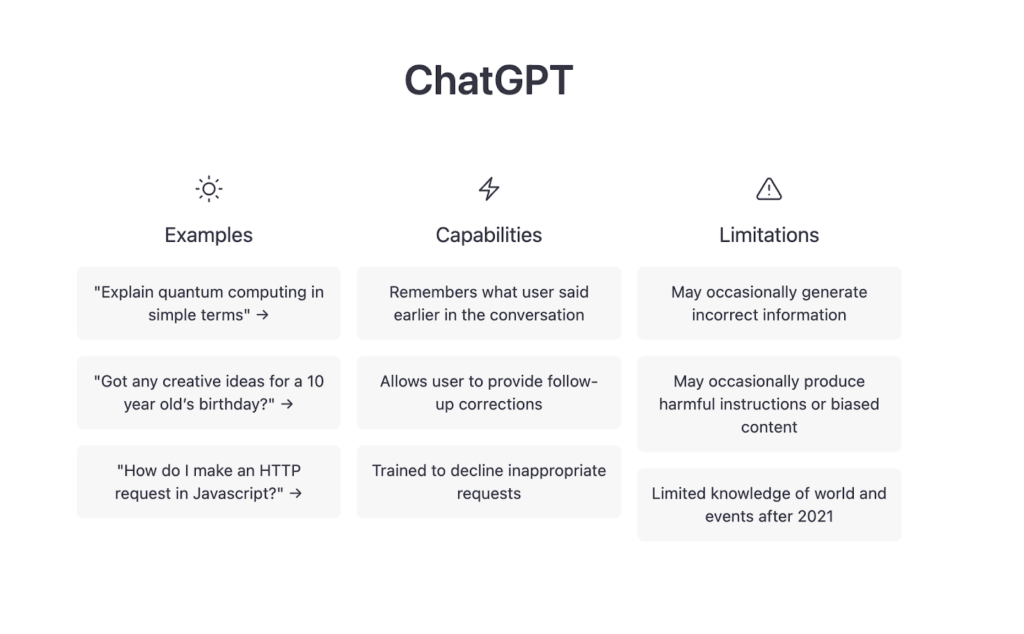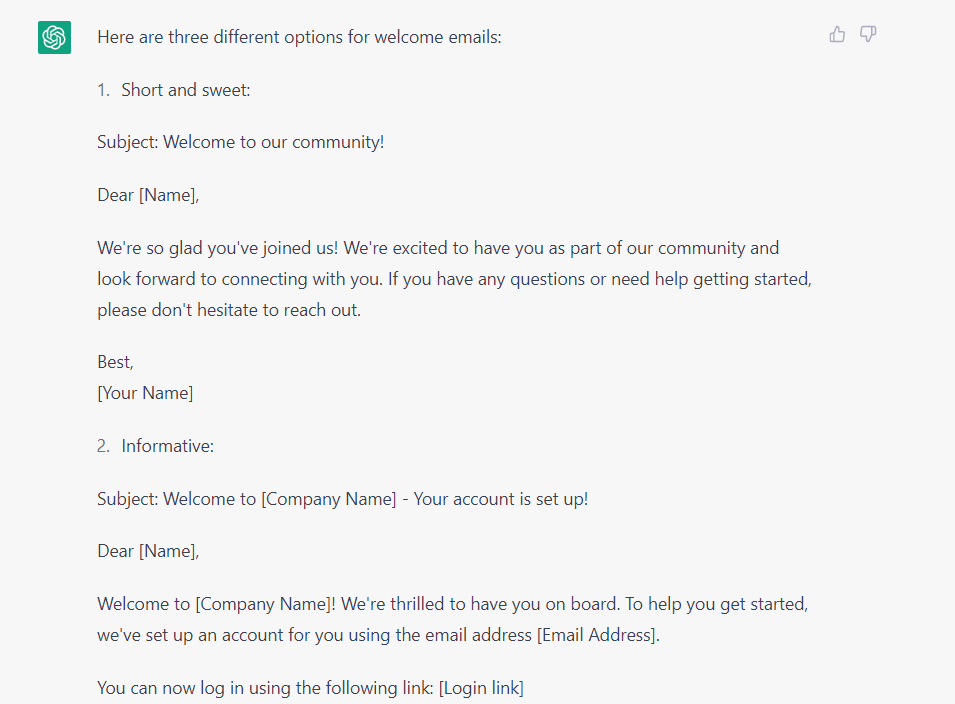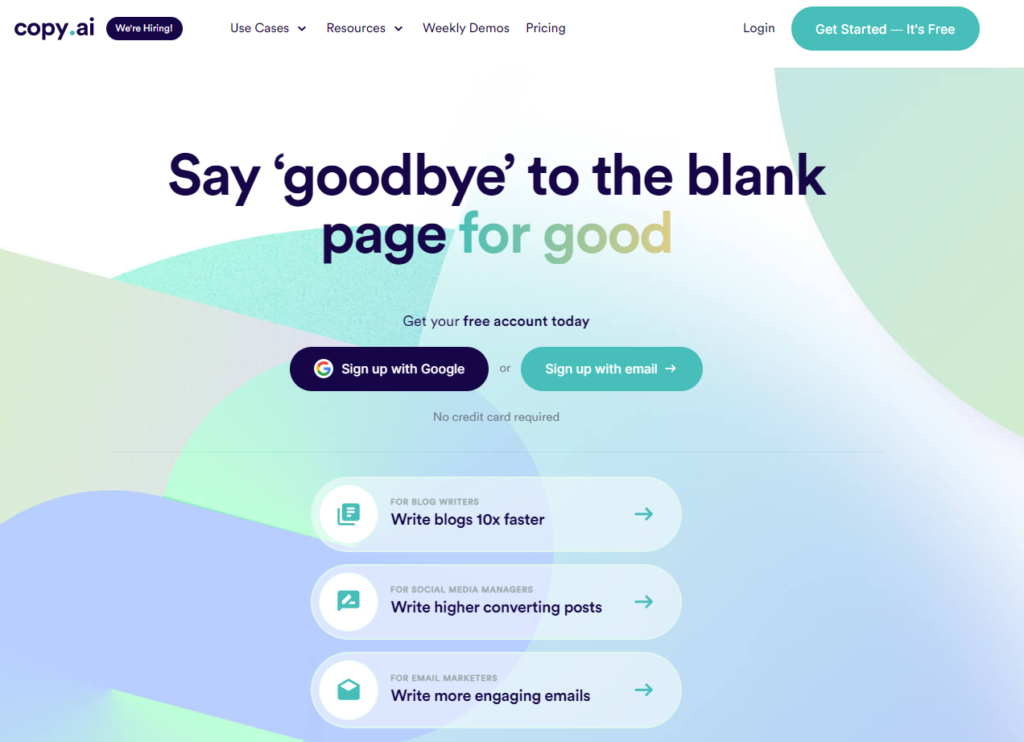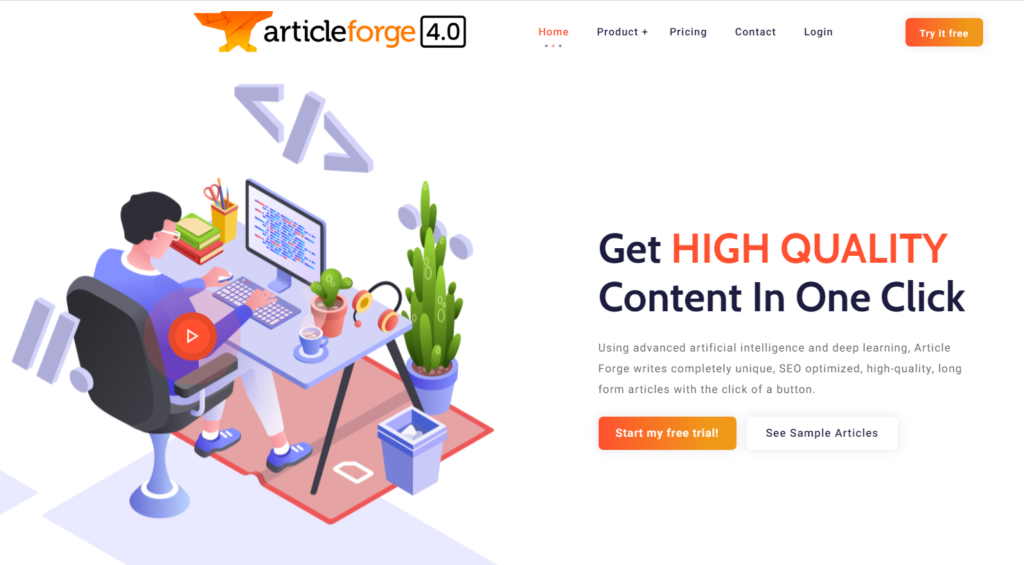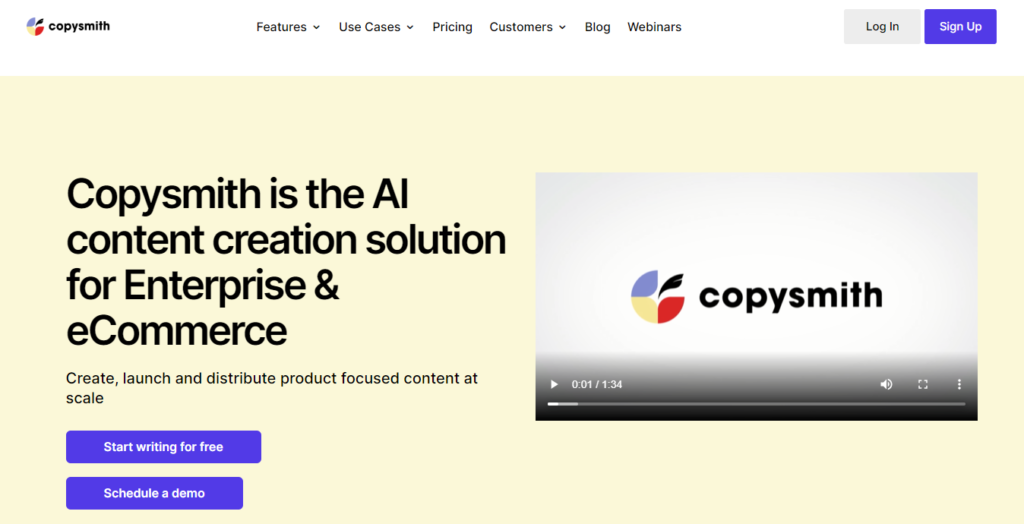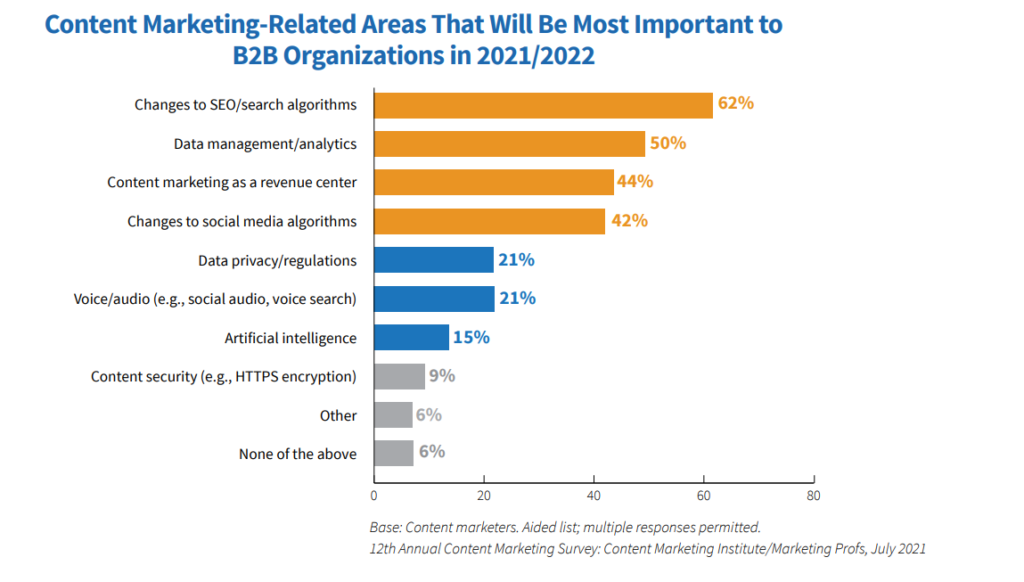Did you know that by 2030, artificial intelligence and automation are expected to take over the occupations of 30% of the workforce in most countries and at least a third of the constituent activities of 60% of jobs? Artificial intelligence (AI) has existed since the 1950s, but companies have recently started using AI content-generation tools to create original text on demand.
The most popular use cases of AI writers are generating social media copy and blog posts. Still, they can also be used for other marketing needs, such as email campaigns and advertisements.
In this article, you’ll learn the main applications of content generators. We’ll also look at five of the best solutions currently available, and we’ll touch upon the potential downturns of using such tools.
Table of Contents
So, What is an AI content generation tool?
An AI content generation tool is software that uses artificial intelligence (AI) algorithms to facilitate the content writing process. It typically requires human input to set up the parameters of the content. Then, the AI content generation tool will use AI algorithms to generate a piece of content in line with the instructions and the preset parameters.
AI content generation is based on Natural Language Processing (NLP) and Natural Language Generation (NLG). These methods require various deep learning models that use massive datasets to train AI to identify natural language patterns and generate content applying them. Also, some of the software can fetch data from a given website and use the information to create relevant content for your audience.
What should you look for in an AI content generator?
One of the most important considerations when choosing an AI content generation tool is its ease of use. It shouldn’t take a lot of time to learn how it works, and you should be able to use all of its features without extensive training or instruction. The following are some of the elements you may want to look for in software that will help you create better content:
- A free trial version that gives you a chance to see how the software works before purchasing it
- A user-friendly interface that makes it quick and painless to get started
- A wide range of templates that you can use as a starting point to make writing faster
- The quality output should be consistent and well-written so that you don’t have to do much editing
- The factual accuracy of the content
- An easy way to get help if you need it, either through tutorials or support staff available 24/7 to answer any questions or concerns you may have
- An online community to help you with your work and answer any questions you have about the software
- A price that’s affordable for your business or personal needs
Let’s explore some of the most popular AI content-generation tools currently available.
5 Best AI content generation tools to consider
Jasper – Best for marketing and sales teams
Jasper is a content generation tool that has seen several branding changes from Conversion.ai to Jarvis.ai, and now to Jasper.ai. With over 50 templates and supporting more than 25 languages, Jasper can help you generate new ideas for blog posts, landing pages, ads, emails, and more.
It gives you greater control over text by integrating with tools like Surfer SEO, Grammarly, and Copyscape to ensure your content is engaging, error-free, and completely original. This integration capability makes it easy to ensure your copy is optimized to rank in search engines and attract visitors alike.
The Jasper Facebook community of about 70,000 users is particularly helpful if you face any challenges with understanding and using the tool.
Free trial: Yes.
The trial lasts five days. However, you’ll have to provide Jasper with your credit card information first so that you can use it.
Pricing: Jasper’s pricing packages start at $49/month for 50,000 words generated and up to 5 users per account.
ChatGPT – Best for individuals or organizations looking for an AI-powered conversational model to answer questions, generate text, or complete a wide range of language-related tasks
ChatGPT, created by OpenAI, is a conversational AI model that uses machine learning algorithms to generate human-like responses. It’s based on OpenAI’s latest development, the prominent language model (LLM) software, launched on November 30, 2022. The tool uses a neural network that processes text and produces a response determined by the input it receives. Taking into account the entire context of the conversation, ChatGPT can create highly relevant and meaningful responses. This makes it ideal for use cases such as customer support or chatbots.
You can also use ChatGPT as an AI content generation tool to create blog posts, product descriptions, emails, and other forms of written content. This can save time and effort compared to manual writing while still delivering good-quality informative and engaging content.
An example of a generated ChatGPT welcome email
Additionally, ChatGPT can be fine-tuned to your specific needs, allowing you to train it on your data and create content customized to your brand voice, tone, and style. This can result in generating more accurate and relevant content for your audience.
Free trial: The program is in beta mode and can be used for free. OpenAI’s idea is to allow the massive usage of ChatGPT so that users can provide feedback on their experience, which will then be incorporated to improve the content generator.
Pricing: ChatGPT’s pricing follows the pay-as-you-go principle and starts at $$0.0004 per 1K tokens, equal to about 750 words.
Copy.AI – Best for digital marketers, marketing agencies, and business owners
Copy.ai is an AI-powered content generator that helps businesses create blog post sections, social media posts, product descriptions, and more. The tool is also highly versatile, generating content in various styles and tones to suit different industries and purposes. This makes it an ideal asset for many businesses, from small startups to large corporations.
In addition, CopyAI offers over 100 writing templates and supports more than 25 languages. It provides various resources to help you take full advantage of the app and learn how to use it like a pro.
There are weekly demos, helpful FAQs, tips and tricks sections, blog posts, and available customer support services. The Facebook group called “CopyAI – Official Group” has more than 17k members, including the founders of CopyAI, Chris Lu and Paul Yacoubian. So, it’s guaranteed – you’ll get answers to all of your questions.
Free trial: Yes.
You can take advantage of the 7-day trial of the Pro plan. Copy.AI offers a free option with a monthly limit of 2,000 words.
Pricing: The starter plan at Copy.ai is priced at $49 per month, providing you with access to a wide range of copywriting tools and the ability to write unlimited words each month.
Article Forge – Best for bloggers, content marketers, and business owners
Article Forge is an AI writing tool that claims to write plagiarism-free and SEO-optimized articles within 60 seconds. The program uses Google’s artificial intelligence technology to research and generate long-form content of up to 1,500 words, including engaging and relevant titles and subheadings.
You can edit the generated articles in the Article Forge editor and export them as a PDF or HTML. The content generation tool supports seven languages and integrates with WordPress so that you can post your articles directly. Other valuable integrations include SEO AutoPilot, Cyber SEO, RankerX, GSA Search Engine Ranker, and SEnuke TNG.
Free trial: Yes.
Article Forge offers a 5-day free trial and a 30-day money-back guarantee.
Pricing: The AI generator provides three pricing plans starting from $27 to $117 per month based on the amount of content you expect to write:
- $27/month for up to 40,000 words
- $57/month for up to 250,000 words
- $117/month for over 250,000 words.
Copysmith – Best for enterprise and eCommerce marketers
Copysmith is a copywriting tool that uses AI technology to generate product descriptions, ad copies, landing pages, and other marketing content. The software promises to deliver high-quality content that is optimized for search engines. Copysmith also offers plagiarism checking by using Copyscape to ensure the generated content is original.
The platform offers a wide range of templates for ads, product descriptions, blogs, and more, and a range of customization options to fine-tune your content’s tone, style, and language. Copysmith integrates with various tools and platforms like Google Ads, Shopify, Frase SEO Enhancer, Zapier, Google Docs, and WooCommerce to make content creation easy. The AI tool also features a Google Chrome extension to quickly generate content while browsing the web without switching to another platform or software.
If you need help or want to ask questions about Copysmith, you can find their support through various platforms like email, LinkedIn, Facebook, Twitter, and Instagram.
Free trial: Yes.
A 7-day free trial is available, with no credit card required.
Pricing: The platform has three pricing plans: Starter priced at $19/month for 5 users, Professional at $59/month for 10 users, and Start-Up at $299/month for 20 users.
- The Starter plan includes 20,000 monthly words and 20 plagiarism checks.
- The Professional plan offers 80,000 monthly words and 100 plagiarism checks.
- The Start-Up plan provides unlimited words, plagiarism checks, custom development, bulk import & export, and an account manager.
What can you use AI content creators for?
AI content generation tools’ primary purpose and advantage is producing large amounts of content on demand within minutes, freeing marketing teams from mechanical tasks that drain productivity and time. Such tools are extremely useful for creating different versions of a micro-copy, such as:
- Article titles
AI content generators can equip you with a list of article title suggestions. You can use them directly or get inspiration when you feel out of ideas. Let’s look at the title suggestions generated by ChatGPT following precise instructions.
- Blog post sections
AI content-generating tools can create whole blog post sections, developing a particular subheading into a sequence of paragraphs.
- White Paper and e-book sections
AI content generators can produce extended content, considerably accelerating e-book creation.
- Product descriptions
This is a typical use case of AI content generators, which provide the brand, the product name, the model, and parameters that can pump out product descriptions that can do a perfect job. It is particularly helpful when you have thousands of items to describe and offer to your potential customers. You only need to make sure your descriptions are unique and informative so you can bring real value to your leads.
- Email subject lines
Whether running a marketing campaign, guest post outreach, or email follow-up, the subject line is one of the essential elements of your emails, making your recipient open or skip your message. Therefore, using an AI writer can save the day – you can get some ideas or use the suggestions to A/B test your campaigns.
- Email copy
In addition to equipping you with subject line suggestions, an AI content generation tool can write the full copy of your email if you provide proper directions.
- Ad copy
Whether you’re running Facebook, Instagram, Twitter, or Google Ads, you need a captivating caption. Ai writers can pump out a full list of options so you can select the best one or use some of the ideas suggested.
When you choose the format you want and enter your talking points, the tool automatically produces multiple versions of relevant content. Now, it’s up to you to make your choice, apply some edits to better target and voice the copy, and use it to save valuable time and effort for more strategic activities.
Top cool ways to use AI tools for your website
Creating website content can be a demanding and time-consuming task. Coming up with fresh and well-thought-out ideas, focusing, and finding the best wording for your thoughts are among the most common challenges writers face.
AI content-generating tools come with several benefits: time-effectiveness, the ability to produce large amounts of SEO-focused content on demand, and the potential to improve. Here’s how this technology can help you overcome writer’s struggles:
Provide engaging content ideas
You can get a list of topics and ideas for your blog and video content. You only need to provide general information about your industry, niche, or product to make the AI content generator come up with several options you can choose from.
Create blog post outlines
You can instruct an AI-enabled content generator to complete an outline for you. To use this feature, simply enter your blog post’s title and your desired tone of voice. Moreover, the software can create titles and help you brainstorm content ideas.
Overcome writer’s block
Sometimes, even the most experienced writer has trouble coming up with ideas and unique interpretations of a subject. Having a tool to generate various content suggestions can provide sources of inspiration and spark creativity. Even if you can’t use the whole content, the tool pumps out; you can still pick some crisp thoughts and intriguing points. You can then develop them using your voice and style.
Generate your first draft
Let’s face it: producing top-quality content can be tedious and time-consuming, and every second counts in the age of deadlines. An AI tool can create your first draft in a matter of seconds. Select the type of content you want and the tone of voice, and include the talking points. You will get a first draft of the content to revise and edit. You can then tweak the content to fit your brand voice and audience’s needs.
Create an end-to-end brand growth strategy
You can use an AI-enabled tool to craft an overall brand strategy, including identifying your buyer persona, product description, website content, social media, and channels to engage with your potential customers.
Perhaps this is when you start thinking, “It’s too good to be true,” and you have a point.
AI: A Blessing or a curse? A closer look at its potential problems
Highly intelligent and helpful as it may be, the most recent AI-enabled solutions have disrupted the landscapes of higher education, content marketing, code writing, and journalism. Even search engine giants like Google are alarmed and threatened by the extensive capabilities of ChatGPT to provide prompt and relevant answers to queries. What’s the other side of the same coin?
Although the LLM software is widely feared, more optimistic interpretations claim that the AI-powered chatbots and content generators are more hype than harm and could even offer some help to colleges and universities by providing students with new ways to learn, such as critical analysis of AI-generated essays and spotting inaccuracies.
Also, it’s long-established that AI will not take over human writers of creative and persuasive pieces. Using content generation tools brings some drawbacks that could affect the quality of the content, such as:
Missing human touch
No matter how advanced the technology is, it will never be able to replicate the human ability to understand emotions. You may find that the AI content sounds robotic and won’t do the trick, which brings us to the next point…
Lack of human logic
Sometimes, the generated content doesn’t make sense and may be too repetitive. So, you can’t entirely rely on AI. You’ll have to read and edit the content first before publishing. What’s more, there is…
Lack of control over the quality
If there’s no human oversight, there’s no guarantee that you’ll end up with high-quality copy each time you use an AI. You may find yourself spending too much time and money editing content that’s been poorly generated.
Potential issues with search engine algorithms
AI tools might produce content that looks great in the first place. However, the included keywords may sound unnatural. Google may penalize your website for keyword stuffing or…
Duplicated content
AI-generated articles are often similar to existing content. Once you input a prompt, the AI tool uses the information and data around the web to generate content that matches your needs. However, this could lead to plagiarized content, which Google penalizes by lowering rankings and giving search results less weight.
In light of the points we have just made, the next question may sound entirely rhetorical. Yet, let’s state it clearly…
Should you entirely rely on AI now?
Figures are indicative. According to a Content Marketing Institute survey, only 15% of content marketers will adopt AI in their content marketing strategies.
Therefore, the best way to use content creation tools these days is to have them generate ideas so you can pick some sparks of inspiration. Although AI can sometimes create really good marketing and promotional content, you’d still need a professional writer to brush it up and add a human touch.
Takeaway: How can you take the best of the two worlds?
If you are a marketer or a business owner, one way to take advantage of AI content generation tools and human writing is to use AI to generate a rough draft. Then, have a human editor review, refine, and add personal touches to make the content more human-like and engaging.
This approach can result in content with the speed and efficiency of AI-generated content and the touch of humanity from a human writer. Another way is to leverage AI to assist your in-house or freelance writers by suggesting ideas, titles, keywords, or sentence structure, saving time and streamlining the writing process.
If you are a content writer and opt for an AI-generated rough draft, edit and refine the content to make it more engaging, accurate, and tailored to the specific audience. Also, tap into the capacity of AI content generation by using the tools as a starting point or inspiration for your creativity, and never rerun out of blog post ideas.
